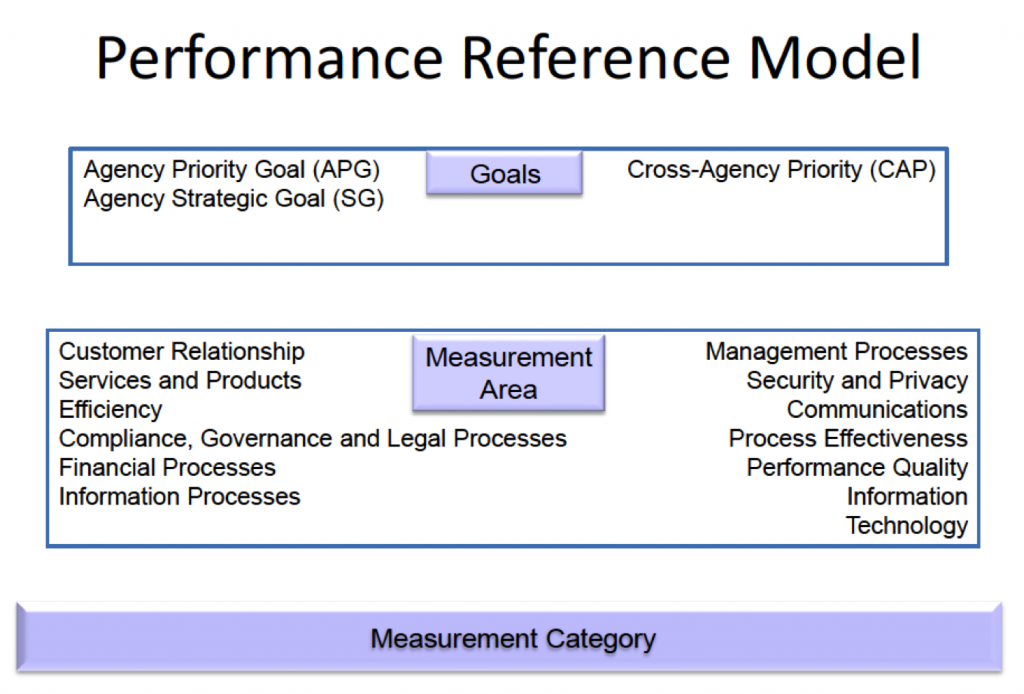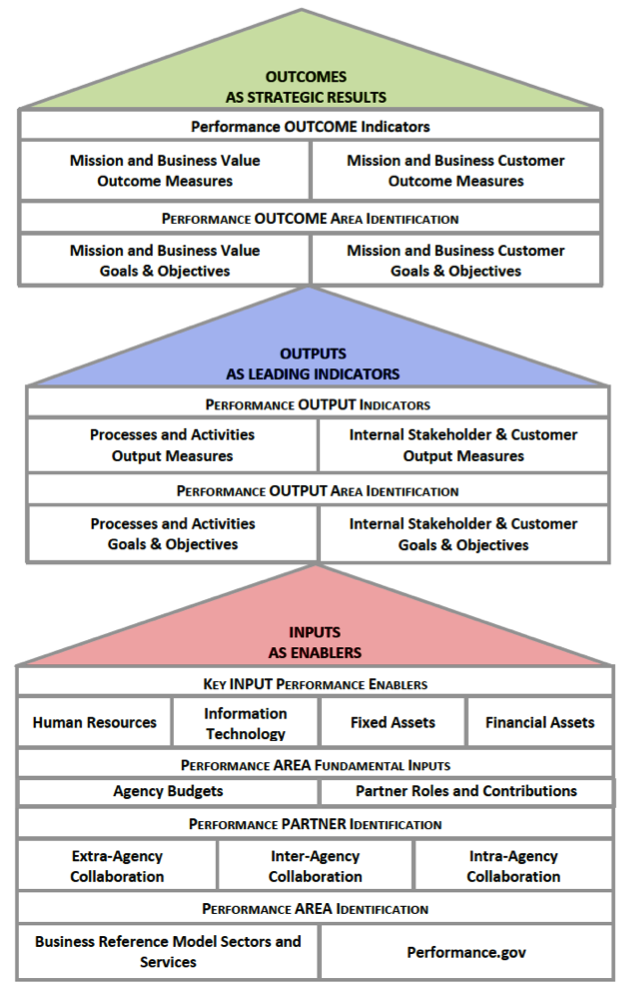Introduction to the Performance Reference Model
Purpose of the Performance Reference Model
The Performance Reference Model (PRM) is designed to provide linkage between investments or activities and the strategic vision established by agencies and the Federal government. Historically, linking information management investments and activities has been anecdotal due to a lack of standard approach to describing Agency and cross agency performance attributes. The GPRA Modernization Act of 2010 requires the government to publish performance information through a central web site and make strategic plans and performance reports available in machine readable formats. This advance enables more comprehensive and consistent linking of investments and activities to Agency strategic goals and objectives, Agency priority Goals, Cross Agency Priority goals and management areas of focus. The PRM leverages the requirements of the GPRA Modernization Act to establish mechanisms to link directly to the authoritative performance elements published in compliance with the law and provides the means for use of future developments in the mandated central performance website Performance.gov.
Structure of the Performance Reference Model
There are three areas to the Performance Reference Model. The first is the Goal. This enables grouping of investments and activities through a common and authoritative framework established by agencies in compliance with OMB direction and the GPRA Modernization Act. It allows the identification of common performance elements across investments or activities, and in the future will enable cross-platform information linkages between systems such as Performance.gov and the IT Dashboard. This linkage provides the logical relationships necessary to consistently provide much richer insights into details of the supported performance areas than previously feasible.
The second area of the Performance Reference Model is Measurement Area. This describes the manner in which the investment or activity supports the achievement of the supported performance element identified by the Agency Goal. Measurement Areas apply to the more detailed performance indicators associated with the investment of activity rather than the functions of the investment or activity. Investment or activity performance indicators should have a clear linkage to the activities, of course, but it is important to recognize that investments or activities may align to multiple measurement areas.
The third area, Measurement Category, refines Measurement Area. Any Measurement Category may be applied to any Goal.
Using the Performance Reference Model Taxonomy
Integrating CPIC (Exhibit 300) Performance Reporting with the FEA PRM
As part of Exhibit 300 investment proposals, federal agencies are required to:
Describe the relationship between investment and agency strategic goals. A narrative explanation of the investment’s specific contribution to mission delivery and management support functions is required in Section B for the Exhibit 300A. Investment owners must identify how the investment contributes to the agency target architecture and links to performance objectives in the published agency strategic plan. The PRM code for the most closely associated performance objective is required.
Provide investment-specific performance measures that quantify the intended performance benefits. Each measure must be categorized using a FEA Performance Measurement Category, and investment owners must ensure that the measures are balanced and drawn from multiple measurement categories. Performance metrics will be reported on the IT Dashboard.
Report on investment results using these measures monthly, quarterly, semi-annually and annually.
PRM Touchpoints with other Reference Models
The PRM, like all other reference models, is intended to work in concert with other reference models. The combined descriptive qualities of the multiple perspectives afforded by assigning different reference model perspectives to investments or activities can provide rich insights into what, why and how the investments or activities are undertaken. Previous versions of the PRM included mission function characteristics that were redundant to the BRM. In this version of the PRM the Measurement Category codes have been streamlined to better identify the means by which performance is achieved. Including BRM and PRM mappings with an investment or activity provides information about the strategic basis (why) through the Agency Goal, the means (how) through the measurement category, and the mission functions involved (what) through the BRM taxonomy. Additional mappings to other reference models provide further context for the investment or activity with the SRM providing information about risk, the DRM about the information involved and the ARM and IRM providing the technical details about the implementation.
touchpoints image
Associated Methods/Best Practices for the PRM
Line of Sight
Central to the value of the PRM is the concept of line of sight. Line of sight is the idea that the work done at lower levels of detail has a clear path to the outcomes of the agency. The PRM Line of Sight essentially forms a value chain for tracing lower level investments and activities to higher level outcomes. The PRM provides significant capability in regard to line of sight. The illustration below demonstrates the key components of the PRM Line of Sight.
Selecting a Balanced Set of Exhibit 300 Performance Measures
With the revision of the FEA PRM, there is now a requirement to reclassify Exhibit 300 performance measures based on the revised FEA PRM measurement categories. The overall purpose of performance measures is to provide detailed insight into the value proposed and realized by the investment. When measures intuitively align with milestones and narrative, the reviewer can more easily envision what value the investment achieves or will achieve, as well as when proposed enhancements in benefits will come on line and begin to realize value.
A methodology for selecting and classifying a balanced set of Exhibit 300 performance measures using the revised FEA PRM is provided below.
The first step in selecting performance measures, or in reviewing the current performance measures for an investment, is to compare investment narrative, milestones, and measures with each other to ensure that they are mutually reinforcing, that is, that they tell the same story. Part I, specifically in the narrative blocks, presents the overall context in which the investment will be understood by reviewers. The language used to describe milestones and performance measures, as well as the performance measures themselves, provided in Part X Section C, should be designed to reinforce the relevance of planned spending to Part I narrative and to showcase achievements to date.
In the Exhibit 300B, Section C, investment owners are required to provide operational performance metrics of two essential types: Results Specific and Activities and Technology Specific.
Results-specific measures should reinforce the benefits summarized in the narrative or substantiate technology cost requirements. If a new capability will result in a significant reduction in the time required to complete a particular customer service, for example, the planned business cycle time reductions need to be emphasized in the narrative and reinforced in the investment performance measures. If a new technology capability will result in a significant increase in electronic workload, then the corresponding needed increases in infrastructure should be described as well as included in the budget.
Technology-specific measures should provide insight into the technology cost drivers for the investment or provide information about the soundness of its performance. For example, a capability that requires an investment in full fault tolerance during periods of high demand would indicate the importance of performance measures to show whether the investment is performing at the required extremely high availability standard.
PRM Summary
Simply put, the Agency Goal provides the means to identify the strategic element supported by the activity or investment while the Measurement Category identifies how the activity or investment supports that goal. Using these two aspects of the Performance Reference Model it is now possible to understand how multiple investments or activities work in complementary fashion to support Agency or cross-agency performance. This combined structure is useful for focusing investment or activity purpose on larger strategic contexts. Performance indicators at the investment or activity level should clearly align with the strategic elements identified in the Agency Goal and Measurement Category.
The detailed taxonomy with definitions is available in Taxonomy G.

